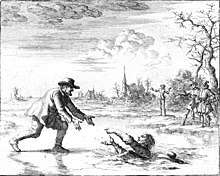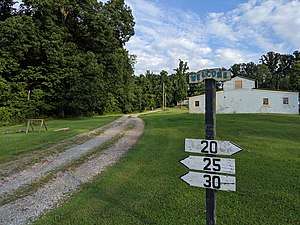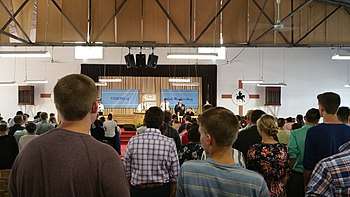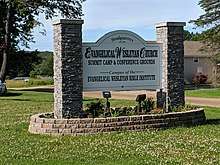Conservative holiness movement
The conservative holiness movement is a loosely defined group of conservative Christian denominations with the majority tracing their origin back to Methodist roots and the teachings of John Wesley, and a minority being Quakers (Friends) that emphasize the doctrine of George Fox, as well as River Brethren who emerged out of the Radical Pietist revival. This movement became distinct from other Holiness bodies in the mid-20th century amid disagreements over modesty in dress, entertainment, and other "old holiness standards" reflective of the related emphases on the Wesleyan–Arminian doctrine of outward holiness or the Quaker teaching on the testimony of simplicity or the River Brethren teaching on nonconformity to the world, depending on the denomination.[1]
| Part of a series on |
| Methodism |
|---|
 |
|
Theology |
|
Organization
|
|
Other topics
|
|
|
| Part of a series on |
| Anabaptism |
|---|
 Dirk Willems (picture) saves his pursuer. This act of mercy led to his recapture, after which he was burned at the stake near Asperen (etching from Jan Luyken in the 1685 edition of Martyrs Mirror) |
|
Background |
|
Distinctive doctrines |
|
Largest groups |
|
Related movements |
|
|
History


The Holiness movement was largely contained within mainline Methodism during the 19th century, with some members of the holiness movement continuing to remain in the mainline Methodist Churches to this day (the "stay-inners"). Wesleyan-Holiness doctrine influenced adherents of other denominations as well. By the 1880s a persistent wave of "come-outism" was beginning to gather steam. The come-outers were concerned that mainline Methodism had begun to water-down Holiness teachings and even shun its more outspoken proponents.
The majority of the denominations which now comprise the Conservative holiness movement were once among a number of Holiness movement groups which had a history of coming out or having left mainline Methodism to teach and practice Holiness doctrine uninhibited. The denominations that left the mainstream holiness movement and mainline Methodism to form the conservative holiness movement did so because they saw a relaxation of the prohibitions on certain behaviours that they considered to be "worldly". The list of prohibitions varies from denomination to denomination, but the prohibitions include the wearing of gold (which includes wedding rings), television in the home (an extension to previous bans on theater patronage), women not cutting their hair (in accordance with historic interpretations of I Corinthians 11), the prohibition of women wearing short skirts, wearing short sleeves (most recommending the sleeve to be at or below the elbow), not wearing shorts, the avoidance of bowling allies and skating rinks, and the condemnation of professional sports, especially on the Sunday Sabbath. Members of denominations in the conservative holiness movement also practice temperance and teetotalism, thus abstaining from alcohol and other drugs.[2] Each major denomination enforces some of the disciplines listed above, so there is some variation amongst the groups. It is these disciplines that define the conservative holiness movement.
The Holiness movement, for the most part, huddled together tightly from its early history to later when Pentecostalism was competing for the hearts and minds of its adherents.
During the Fundamentalist–Modernist Controversy of the 1920s and onward, most Holiness groups found themselves at home in the Fundamentalist camp or allied with them.[3] While many Holiness groups made the jump toward the Evangelical movement in the late 1930s, there were groups that felt their Holiness peers were drifting away from Biblical inerrancy and cultural separation.
The Reformed Free Methodist Church left the Free Methodist Church in 1932 and the Emmanuel Association left the Pilgrim Holiness Church in 1937—both schisms were due to what the departing bodies perceived as a laxity in traditional doctrine and standards.[4][5] Samuel West spearheaded the formation of the Reformed Free Methodist Church, which held its annual Flatwoods Camp Meeting in Perryopolis, Pennsylvania; the RFMC emphasized the traditional Methodist doctrine of plain dress.[5] The Emmanuel Association, belonging to the subgroup of "Holiness Pacifists" in the conservative holiness movement, is known for its opposition to warfare and its holiness standards are codified in a manual known as "Principles of Holy Living".[4]
By the post-World War II era, a more relaxed societal attitude toward morality and theological differences continued to accompany many mainstream Holiness conferences, districts and local churches reinforcing longstanding prohibitions on behavior in their governing documents. Not at home with other Fundamentalist alliances (which had a more Calvinistic and non-Holiness tone to them), an Interdenominational Holiness Convention (IHC) was called at a Wesleyan Methodist campground in Fairmont, Indiana, in 1951. Entire sanctification (in Methodism) or Perfectionism (in Quakerism), as well as traditional holiness strictures on dress and entertainment, held a prominent place in convention sermons. The swelling divorce rate, the relentless spread of Communism (with its promotion of state atheism), and the effects of television on society were also prominent themes.[6] Participants resisted a call to form a new denomination, but became an ally toward a series of prior and future institutional secessions.
In 1955 the Bible Missionary Church (BMC) was formed in Idaho and soon grew nationwide as local congregations left the Church of the Nazarene over "worldliness" issues.
In 1963, another schism in the Free Methodist Church led to the formation of the Evangelical Wesleyan Church (EWC).[7]
In 1963, the Pilgrim Holiness Church of New York seceded from the Pilgrim Holiness Church to become an independent organization (in 1966–68, the Wesleyan Methodist Church and the Pilgrim Holiness Church proposed a merger to form the Wesleyan Church, which has more in common with the Evangelical Holiness movement churches such as the Nazarene Church).
In the wake of the Wesleyan Church merger, the Bible Methodist Connection of Churches, the Allegheny Wesleyan Methodist Connection of Churches, the Bible Methodist Connection of Tennessee (Tennessee Bible Methodists), the Bible Methodist Connection of Alabama (Alabama Bible Methodists), Bible Methodist Connection Mid-America (formed in 2018), Bible Covenant Church, Pilgrim Holiness Church (Midwest Conference), International Conservative Holiness Association, Pilgrim Nazarene, Wesleyan Nazarene, Emmanuel Missionary Church, Bible Holiness Church, and Wesleyan Holiness Association were organized.
As of August 2019 the Pilgrim Nazarene Church (PNC) voted to join the Bible Methodist Connection. While not all the churches took part in the merger it is estimated that approximately two-thirds of the PNC churches left to join the Bible Methodist Connection.
The Brethren in Christ Church, a River Brethren denomination that emerged out of Radical Pietism, entered into a schism in 1963 resulting in the formation of the Calvary Holiness Church, a conservative holiness denomination which continues to emphasize traditional River Brethren beliefs, such as the wearing of a headcovering by women, plain dress, temperance, footwashing, and pacifism.[8]
Other constituent bodies include: Church of God (Holiness); the Central Yearly Meeting of Friends that emerged among Quakers emphasizing George Fox's doctrine of perfectionism; and God's Missionary Church, formed by individuals affected by local revival meetings.
Social change constantly confronts Conservative Holiness Christians. The Church of God (Holiness) in 1999 removed a ban on owning televisions, urging charity over “the ownership or use of television, videos, movies, the internet, and such like.” Other denominations in the conservative holiness movement, such as the Evangelical Wesleyan Church, continue to forbid the watching of television.[9]
Denominations

Denominations and associations of churches aligned with the conservative holiness movement include:
- Wesleyan Methodist Church (Allegheny Conference)
- Bible Holiness Church
- Bible Methodist Connection of Churches
- Bible Methodist Connection of Tennessee[10]
- Bible Missionary Church
- Calvary Holiness Church Philadelphia[11]
- Central Yearly Meeting of Friends[12]
- Church of God (Holiness)[13]
- Crusaders Churches of America[14]
- Emmanuel Association[15]
- Evangelical Wesleyan Church
- Faith Missionary Association
- God's Missionary Church[16]
- Independent Conservative Holiness Churches
- International Conservative Holiness Association[17]
- Pilgrim Holiness Church (Midwest Conference)
- Pilgrim Holiness Church of New York[18]
- Primitive Methodist Church
- United Holiness Church (Southeast Indiana)
- United Holiness Church of Korea
- Wesleyan Holiness Association of Churches
- Wesleyan Holiness Alliance (Bartlesville, Oklahoma)
- Wesleyan Nazarene Church
- Wesleyan Missionary Church
- Wesleyan Tabernacle Association
- Worldwide Faith Missions[19]
Educational institutions

Colleges and schools affiliated with the conservative holiness movement include:
- Allegheny Wesleyan College[20] (Salem, OH)
- Bible Missionary Institute (Rock Island, IL)
- Evangelical Wesleyan Bible Institute (Cooperstown, PA)
- Faith Bible School (Mitchell, SD)
- Thompson Bible Institute (Bellevue, OH)
- God's Bible School[21] (Cincinnati, OH)
- Hobe Sound Bible College[22] (Hobe Sound, FL)
- Kansas Christian College[23] (Overland Park, Kansas)
- Northwest Indian Bible Institute[24] (Alberton, MT)
- Penn View Bible Institute[25] (Penns Creek, PA)
- Union Bible College[26] (Westfield, IN)
Missions
A number of mission endeavors exist within the conservative holiness movement with active mission fields in the Philippines, South Africa, Ukraine, Haiti, Peru, Mexico, Asia, Eastern Europe, India, Myanmar, and South Korea. Listed below are a few of the mission organizations affiliated with the conservative holiness movement. Most of the denominations listed above also maintain their own missions boards and departments for both Home and Foreign Missions.
Notes
- Sidwell, Mark, "Conservative Holiness Movement: A Fundamentalism File Report," http://www.lcoggt.org/history/conservative_holiness_movement.htm
- The Discipline of the Allegheny Wesleyan Methodist Connection (Original Allegheny Conference). Salem: Allegheny Wesleyan Methodist Connection. 2014. p. 37.
- "Archived copy" (PDF). Archived from the original (PDF) on 2016-04-14. Retrieved 2015-02-16.CS1 maint: archived copy as title (link)
- Lewis, James R. (2001). The Encyclopedia of Cults, Sects, and New Religions. Prometheus Books. ISBN 9781615927388.
- Jones, Charles Edwin (1974). A guide to the study of the holiness movement. Scarecrow Press. ISBN 9780810807037.
- Leonard Sankey, “Let’s Talk Dayton Convention,” Convention Herald, May–June 1999
- Kostlevy, William (3 August 2009). Historical Dictionary of the Holiness Movement. Scarecrow Press. p. 31. ISBN 9780810863187.
- Lewis, James R. (2002). The Encyclopedia of Cults, Sects, and New Religions. Prometheus Books. p. 151. ISBN 9781615927388.
- I. C. Holland, “The Motive for the Motion,” Church Herald and Holiness Banner, 25 Feb. 2000, p. 10.
- "Archived copy". Archived from the original on 2014-02-21. Retrieved 2014-05-15.CS1 maint: archived copy as title (link)
- (CHC Philadelphia)
- CYMF
- Church of God (Holiness)
- Kostlevy, William (2010). Holy Jumpers: Evangelicals and Radicals in Progressive Era America. Oxford University Press. p. 304. ISBN 9780199703364.
- GMC
- (ICHA)
- Pilgrim Holiness Church of New York Website
- Allegheny Wesleyan College Official Site
- God's Bible School Official Site
- Hobe Sound Bible College Official Site
- "Kansas Christian College: 2017-18 Academic Catalog" (PDF). Kansas Christian College. 2018. Retrieved 24 July 2019.
We must keep in mind that prudence involves concern for our influence on the college itself, the conservative holiness constituency we serve, the educational community, and the larger society of which we are a part.
- Penn View Bible Institute Official Site
- Union Bible College Official Site
- Bible Methodist Missions
- Evangelistic Faith Missions
- Hope International Missions
- ICHA Ministries
References
- The Holiness Churches: A Significant Ethical Tradition, Donald W. Dayton
- The Holiness Heritage, by Dr. Brian Black
- A Social Science Perspective On The Conservative Holiness Movement, John Johnson
- The History And Development Of Bible Methodism, A. Philip Brown II
- The History And Organization Of The Wesleyan Church, Bayview Wesleyan Church
- Allegheny Wesleyan Methodist Connection Discipline, Allegheny Wesleyan Methodist Connection of Churches
- Constitution of the Bible Methodist Connection of Churches, Bible Methodist Connection of Churches
- Pilgrim Holiness Church of New York - Who We Are, Pilgrim Holiness Church of New York
- A Presentation Of Perfection, Dr. Mark Eckart (Mainline Wesleyan)
- Handbook of Denominations, by Frank S. Mead, Samuel S. Hill, & Craig D. Atwood
- The Conservative Holiness Movement: A, Historical Appraisal The Conservative Holiness Movement: A Historical Appraisal, by Wallace Thornton Jr.
- From Glory to Glory: A Brief Summary of Holiness Beliefs and Practice, Wallace Thornton Jr.
- Radical Righteousness: Personal Ethics and the Development of the Holiness Movement, Wallace Thornton Jr.
